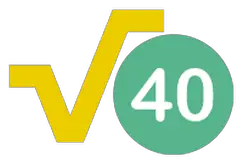Square Root of 40
If you are curious about the value of the square root of 40, it is approximately 6.324. The square root of a number (40 in this case) is a value that, when multiplied by itself, results in the original number (40). The square root of 40 can be expressed in either radical or exponent form:
The radical symbol or radix, represented by √, is a well-known symbol in mathematics. The value for which the square root is being computed is referred to as the radicand and is placed beneath the radical symbol (radix).
- The radical form of the square root of 40 can be expressed as √40.
- Exponent form of the square root of 40: 40^(1/2) or 40^(0.5)
The radical symbol or radix, represented by √, is a well-known symbol in mathematics. The value for which the square root is being computed is referred to as the radicand and is placed beneath the radical symbol (radix).
Calculator for Square Root of 40
If you need to calculate the square root of any number, including the square root of 40, you can use a square root calculator.
Calculation Guide for Square Root of 40
Our aim in the subsequent sections is to detail the procedure of computing the square root of 40, along with answering commonly asked questions such as whether 40 is a perfect square and if the square root of 40 is rational or irrational. Our primary emphasis will be on determining the value of the square root of 40.
All the information required to calculate the square root of 40 can be found below.
All the information required to calculate the square root of 40 can be found below.
What is the square root of 40?
The square root of 40 is a value that, when multiplied by itself, results in 40. Therefore, the square root of 40 is approximately 6.324, since 6.324 x 6.324 is approximately equal to 40.
Hence,
ANSWER: The square root of 40 is approximately 6.324, which can be represented as √40 ≈ 6.324.
Hence,
ANSWER: The square root of 40 is approximately 6.324, which can be represented as √40 ≈ 6.324.
Is 40 a Perfect Square?
Perfect squares are numbers that result from squaring a whole number or an integer, such as 0, 1, 2, 3, 4, 7, 8, and 9. It's worth noting that not all whole numbers are integers, as integers lack decimal or fractional components, unlike numbers such as -5, 7.025, or 5 ½. Squaring a number involves multiplying it by itself, and an example of a perfect square is 81, which is obtained by multiplying 9 by itself (9 × 9). Thus, 9 is an integer or whole number that is not characterized by decimal or fractional components.
In our case, 40 is not a perfect square because it cannot be obtained by squaring a whole number.
ANSWER: 40 is not a perfect square.
In our case, 40 is not a perfect square because it cannot be obtained by squaring a whole number.
ANSWER: 40 is not a perfect square.
Does the square root of 40 belong to the category of rational or irrational numbers?
To put it in simpler terms, an irrational number is a number that cannot be represented as a fraction with integers in the numerator and denominator.
In the case of the square root of 40, the resulting value is a non-repeating and non-terminating decimal, which cannot be expressed as a fraction. Therefore, the square root of 40 is classified as an irrational number.
In conclusion, the square root of 40 is classified as an irrational number.
In the case of the square root of 40, the resulting value is a non-repeating and non-terminating decimal, which cannot be expressed as a fraction. Therefore, the square root of 40 is classified as an irrational number.
In conclusion, the square root of 40 is classified as an irrational number.
Principal square root of 40
For every positive number, there exist two square roots, with one being positive and the other negative. For instance, the square roots of 40 are -6.324 (negative) and +6.324 (positive), since both (-6.324)^2 and (+6.324)^2 are equal to 40. The positive square root is known as the "principal square root." Typically, when we calculate "the square root of a number," we are referring to the principal square root. In the case of the square root of 40, the principal square root is the positive value, which is denoted by √40 = 6.324.
To calculate the square root of 40, we can use various methods, such as prime factorization, long division, or approximation using a calculator. One common method is to use prime factorization to break down the number into its prime factors and simplify the expression to find the square root.
Prime factorization of 40 can be written as: 2^3 x 5
We can simplify this expression by grouping the same prime factors, which gives us:
√40 = √(2^2 x 2 x 5)
√40 = √2^2 x √2 x √5
√40 = 2√10
Therefore, the square root of 40 can be represented as 2√10. This is the simplified radical form of the square root of 40.
To calculate the square root of 40, we can use various methods, such as prime factorization, long division, or approximation using a calculator. One common method is to use prime factorization to break down the number into its prime factors and simplify the expression to find the square root.
Prime factorization of 40 can be written as: 2^3 x 5
We can simplify this expression by grouping the same prime factors, which gives us:
√40 = √(2^2 x 2 x 5)
√40 = √2^2 x √2 x √5
√40 = 2√10
Therefore, the square root of 40 can be represented as 2√10. This is the simplified radical form of the square root of 40.

